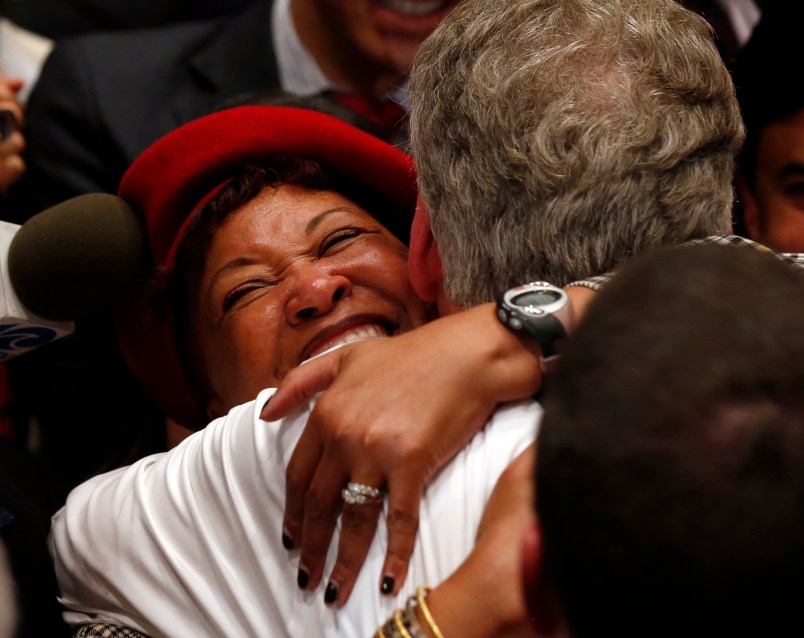On Tuesday night, as Democratic candidate Terry McAuliffe eked out a win over Republican Ken Cuccinelli in the Virginia gubernatorial race, both the media and reproductive rights organizations heralded his victory as a win for and by women. Exit polls revealed that while 45 percent percent percent of men voted for McAuliffe, 51 percent percent percent of women did, revealing a gender gap of six percentage points. But if we dig deeper, we begin to see a recurring trend within that gender gap and the gender gap of recent presidential elections: it is women of color, particularly black women, who help drive it.
The gender gap in voting patterns is nothing new. It first emerged in 1980, when it was revealed that Ronald Reagan had won the presidency with more votes from men than women. In fact, the Center for American Women in Politics shows that a gender gap has been present in every single election since the presidential election of 1980. Overall, women tend to vote more Democratic, and men tend to vote more Republican. Hence, the gender gap.
Yet, as we all too well know, women are not a monolith, and their voting patterns reflect that.
Women are not quite the cohesive voting bloc that political scientists have seen with African-Americans, Hispanics/Latinos or members of the LGBTQ community. Pundits, pollsters and politicians alike often opine about which way the “women’s vote” will go in any given election, rhetorically framing women as a cohesive voting bloc despite evidence to the contrary. Because women are such a large group and constitute the majority of the American electorate, they continue to garner significant media coverage and political speculation. Additionally, the gender gap is not nearly as pronounced as the partisan divide between white voters and black and Latino voters.
In post-election cycles, the gender gap can become yet another way to reinforce the mythical narrative of the monolithic women’s vote.
Much has been made about the gender gap in both of President Obama’s elections. In 2008, the gender gap was 7 percentage points, despite the presence of Sarah Palin as the vice-presidential nominee on the Republican ticket. The gender gap then notably increased in 2012, to 10 percentage points in favor of President Barack Obama over Republican nominee Mitt Romney in what was heralded as a women-dominated election. Fifty-five percent of women voting for Obama compared with only 45 percent percent of men. President Obama’s re-election was largely credited to women voters who overcame his deficits among men.
But, much like Terry McAuliffe’s win in Virginia, that doesn’t tell the whole story.
Some, including MSNBC’s Irin Carmon and Salon’s Joan Walsh, have noted that while McAuliffe may have won the women’s vote overall, he lost the white women’s vote quite handily. According to exit polls conducted by Edison Research, it was black women and black men who really delivered for McAuliffe, giving him 91 percent percent and 90 percent percent of their votes, respectively. McAuliffe didn’t even come close with white women; while 96 percent percent of black women who voted for McAuliffe, only 38 percent percent of white women did. Ken Cuccinelli carried the white women’s vote by 16 percentage points, obtaining 54 percent percent of white women’s votes.
It was the same story in 2012, when 96 percent percent of black women voted for Obama, but only 42 percent of white women did. In fact, Mitt Romney won the white female vote handily with 56 percent percent. Notably, 96 percent of black women voted for President Obama while only 87 percent percent of black men did, revealing a gender gap among black voters as well. Black women are the ones who continually show up for the Democratic party, but you wouldn’t know it from the way we talk about the gender gap.
Unfortunately, we seldom acknowledge the glaring racial disparity within the gender gap and instead focus on static categories of “men voters” and “women voters” that don’t reflect the varying voting patterns within each respective group. Rather than highlighting the fact that black Americans are far and away the most reliable and solid base of the Democratic party — particularly black women in our most recent election cycles — we end up erasing them from the narrative completely by simply referring to the gender gap without any nuance. Black women deliver the votes and seemingly get none of the credit for it.
When we highlight the gender gap, we simply focus on the difference in votes between men and women, without really interrogating the varying degrees of difference between men and women across other identities. In order to truly understand the dynamics at play in McAuliffe’s election and many recent Democratic successes, the gender gap as we know it will not suffice. If we really want to know what is driving the gender gap, race cannot remain an entirely separate category.It cannot be a tangential aside when we talk about voting trends among men and women. We need demographic breakdowns on race and gender to contextualize the gender gap.
It comes down to this: Terry McAuliffe is the governor-elect of Virginia, and he has black women to thank for it.
Rankin is a feminist writer and activist. Her work has appeared at publications such as Salon, RH Reality Check and TruthOut. Currently a graduate student in Women’s and Gender Studies at Rutgers University, she focuses on reproductive politics and the political use of sexual shame. Follow her on twitter at @laurenarankin.






